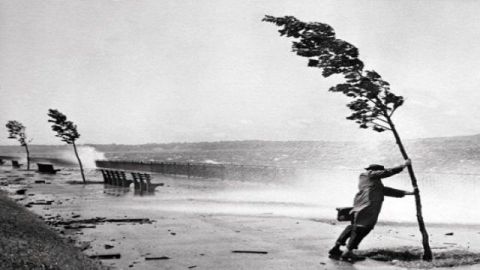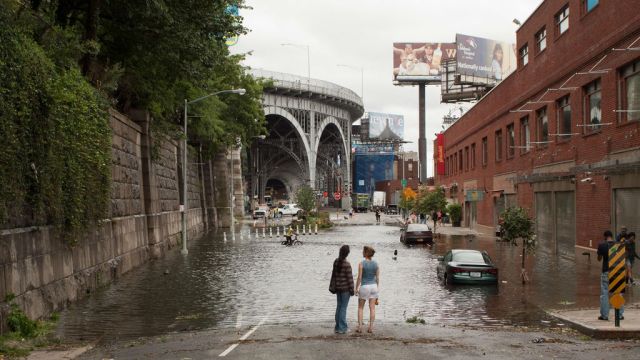Hurricane Irene and Risk perception. They’re BOTH Dangerous

A potentially serious hurricane bears down on tens of millions of people in the Northeast. How will they respond? The psychology of risk perception suggests that some might be at risk not just from the weather itself but also from “The Perception Gap”, the danger that arises when our fears don’t match the facts. In many cases people’s reactions won’t match the realities of the danger, and as a result, some of their choices and behaviors might not maximize their safety.
Hurricanes are thankfully rare in the Northeast, and the more powerful, more dangerous ones, are rarer still. Few threatened by Irene have lost homes or property or loved ones to hurricanes, or even just lost electrical power or water or phone/cable/internet connections for days or weeks, the way people have in the Carolinas, Florida, and the Gulf Coast states, where hurricanes are more common. Hurricanes in the Northeast are like the earthquake that shook that region last week…rare…exciting oddities to Twitter and text about as much as to fear.
That makes this threat (for those of you where the storm hasn’t hit yet) more abstract than viscerally real, and that makes it feel less threatening. It’s an idea, numbers and dots on a map, information about wind and rainfall and storm track, and as alarming as that information may be, risk perception is not just about the facts but how those facts feel. An abstract risk usually doesn’t trigger as much concern as something we’ve actually been threatened by, or suffered from, in the past. So while the warnings will cause high alarm in some, and prompt due precautions by many, a lot of people will fail to take adequate precautions, and that leaves them at greater risk. That is the danger of The Perception Gap.
For the same reason, should evacuations be recommended, some might emperil themselves by not following that advice. Even if evacuations are mandatory, some will resist, to protect their property from thieves, which reflects an additional potentially dangerous instinctive/emotional factor that influences our perception of risk. We naturally weigh risks against benefits. Anyone who stays to protect their property is making a Risk versus Benefit choice that says the risk of a hurricane – which in a mandatory evacuation area includes the risk of dying – doesn’t feel as big as the benefit of protecting their replaceable physical belongings. OOPS!
For those of us who have lived through hurricanes in the Mid Atlantic states and Northeast, another psychological factor will probably diminish concern…the “I’ve lived through this before” effect, a false sense of familiarity. Risk perception research has found that when we grow familiar with a risk…when we have experienced the danger but not suffered…we start to take it less seriously. The problem of course is that not every hurricane is the same. The hurricanes to make landfall in New England in some of our lifetimes –Agnes in ’72, Gloria in ’85, Bob in ’91 – were weaker or smaller than The Great New England Hurricane of 1938 that hit as a Category 3 storm, ravaged the Mid Atlantic states up to southern Quebec, and killed between 682 and 800 people, damaged or destroyed 57,000 homes, and caused damage, in today’s dollars, of $4.7 billion. But few of us around now were around in 1938, so our experience has been with hurricanes as lesser storms, breeding a false sense of “I’ve been through this before” that leads us to take such storms too casually.
(Some in New Orleans made this “I’ve lived through it before, I can do it again” judgment as Katrina bore down, having survived Category 5 Camille in 1965. Not to be melodramatic about it, but some of the New Orleanians who perceived the risk of Katrina that way, – Katrina was ‘just’ a Category 3 – are now dead.)
Then there’s the seductively reassuring, and in the case of big storms false, sense of control. Some may not take adequate precautions, or evacuate, because they think that if things get really bad, then they can get out, or sandbag their house against flooding, etc. This is dangerous hubris, but a common phenomenon of risk perception. The more control you think you have the less afraid you are. Documentaries about the ’38 Great New England Hurricane tell a number of these stories, and some of them are about people who thought they had more control than they did, and perished.
The ultimate example of all of this will be the people who go out in the storm, even down to the waves and surging sea at the coast, to see what it’s like. I was a TV reporter and covered big storms in New England for two decades. It can be exciting. It is also, I promise you, unequivocally scarier than you would think. But then, risk perception isn’t just a matter of rational thinking. Its’ about our gut feelings too.
The real world bears out what the psychological research into risk perception risk has learned. Consider how Floridians behave when hurricanes loom. Their firsthand and relatively frequent experience with the fierce destructive danger of these storms makes the risk more visceral, and they take it seriously. They make their personal preparations, protect property, leave when it’s recommended. They know where the evacuation routes are. Do most of us in the Mid Atlantic and Northeast? Probably not.
Or consider how people in Houston responded to Hurricane Rita, a few weeks after Katrina. The evacuation was unprecedented, far greater than expected by emergency planners. Roads jammed for hours as tens of thousands fled, far more than would probably have left except the terrible power of hurricanes was tragically viscerally real because of what had happened a few hundred miles to the east just days before. In fact, Houston was full of refugees from Katrina, sharing their first hand stories, and making the threat that much more emotionally compelling.
Despite the dramatic coverage of Hurricane Irene as it approaches, as of a few hours ago it looked like it may be a weaker Category One when the heart of the storm comes ashore somewhere in New York or Connecticut, or maybe even just a powerful tropical storm, still dangerous and highly likely to produce serious flooding, but short of Stormageddon. Regardless of the way Irene actually plays out, the way we perceive this risk offers a cautionary tale. It’s just one example of how our perception of risk, an affective/instinctive mix of facts and feelings, cognition and intuition, reason and gut reaction, can pose risks all by itself.





